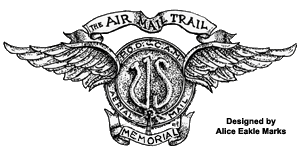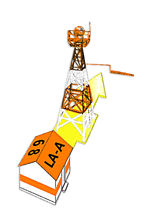 |
||||||
|
||||||
|
||||||
Location / Airway |
||||||
Location / Name
Transcontinental Airway
|
||||||
Observations and Notes |
||||||
Interesting article about Little Lake Pass Beacon from Air commerce bulletin v.6, page 272-273
The beacon tower at Little Lake Pass, Nev. (site no. 49-A on the San Francisco-Salt Lake Airway), stands on a jutting eminence 6,860 feet above sea level, and the caretaker's dwelling nearby is at an altitude of 6,750 feet. During winter the site sometimes is blockaded against ordinary traffic for as much as 4 months at a time, and at its worst, snow shoes are the only available means of getting to and from the station because of heavy snow drifts. Ordinarily, a beacon light site does not have a full-time resident caretaker, but is serviced during periodic inspection visits; and in event of light failure, a special trip is made to the site. At Little Lake Pass, however, and at the few other similarly inaccessible beacon lights, a caretaker lives at the site to maintain and service the light, and he also has responsibility for other lights in the vicinity. Certain Stations on the Federal Airways System usually intermediate landing fields, are known as noncommunication stations because they are not equipped with radio or teletypewriter. The Little Lake Pass, Nev., beacon site can truly be called a noncommunication station, for it does not even have a telephone. The nearest beacon site to 49-A is site 50, Silver Zone, Nev. The tower there is 6,490 feet, and the dwelling is 6, 300 feet above sea level and about 17 1/2 air miles distant from site no. 49A.
The keeper In charge at 49-A made a request to his mechanician for some sort of signal light so that in the event of urgent need a signal might be flashed out to the keeper in charge at site 50. The request was granted and more, for the mechanician arranged for a signal light at site 50 also. So the keeper in charge there could flash back an acknowledgment. About October of 1934, these lights were installed. They were 500-watt course lights with red lenses. It was understood that 49-A in the event of need would flash on his red light and leave it on; that 50 would flash an acknowledgment as soon as he had seen it, and if the need of 49-A was very urgent, he would simply leave his light on-and the keeper at lite 50 would come over as soon as he could, but if the case could wait until morning, then 49-A was to flash four times. Up to the present there has been no need of sending out such a signal, which of course would be a red one. But the idea of sending out an O. K. signal once a week with just a white light was agreed upon. This was done just simply raising the red lens out of the way and when only the white light was showing it was understood just a message was being sent out. As the road up to the station is steep and rather narrow there is a possibility of something going wrong on the way up, so the keeper, when he has visited the town and is returning to his station, flashes a signal to the people at Shafter, his safe arrival at the station after his beacon has started. The Morse code is used for Shafter because it is understood there; with a light the dot is a short flash and the dash is longer in duration. But only short signals previously agreed upon have so far been put to use between the two airway stations. As a rule an O. K. is sent out each Saturday evening just to let it be known all is well at 49-A. |
||||||
Contributors Photos |
||||||
Links |
||||||
|
Make a comment on our Facebook Page "Arrows Across America" about this arrow.
|
||||||
| This site provides historical information only, do not use for navigation purposes. Arrows and Beacons may be on private property, DO NOT TRESSPASS! ALL photos are copyrighted and may not be used without written permission other than for personal use. |
||||||
|
||||||
| Alabama | Arizona | Arkansas | California | Colorado | Connecticut | Delaware | Florida | Georgia | Idaho | Illinois | Indiana | Iowa | Kansas Kentucky | Louisiana | Maine | Maryland | Massachusetts | Michigan | Minnesota | Mississippi | Missouri | Montana | Nebraska | Nevada New Hampshire | New Jersey | New Mexico | New York | North Carolina | North Dakota | Ohio | Oklahoma | Oregon | Pennsylvania Rhode Island | South Carolina | South Dakota | Tennessee | Texas | Utah | Vermont | Virginia | Washington | West Virginia | Wisconsin | Wyoming |



